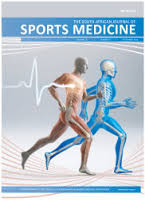Factors associated with lumbo-pelvic pain in recreational cyclists
DOI:
https://doi.org/10.17159/2078-516X/2017/v29i1a4239Abstract
Background: Overuse injuries in cyclists are as high as 85%, with lower back and pelvis pain (LBPP) being common. The lower back and pelvis are pivotal to powering and controlling the bicycle and essential for optimal functioning, comfort and performance. Cyclists spend long, continuous hours in sustained forward flexion, which is regarded as a main contributor to LBPP. Cyclists with LBPP assume greater lumbar flexion but the reason has not yet been established. Objectives: To identify intrinsic and bicycle set-up factors associated with lumbo-pelvic pain in cyclists. Methods: This study was cross-sectional and descriptive. One hundred and twenty-one cyclists in Gauteng, South Africa, participated in this study. The factors proposed to be associated with LBPP were determined to be namely: lumbar curvature on the bicycle in all three handlebar positions, strength of the gluteus maximus (Gmax) and medius (Gmed), extensibility of the hamstrings, control of lumbar movement in the direction of flexion, neurodynamics, active straight leg raise, one leg stance test for lateral pelvic shift, leg length discrepancy and bicycle set-up (saddle height, set-back and angle, handlebar height, forward reach, cleat position). Results: Only the lumbar curvature in the brake lever position (p=0.03) and weakness of the Gmed (p=0.05) were related to LBPP in cyclists. Conclusion: This study was the first to assess the relationship between the multiple factors described above and LBPP in cyclists. Understanding the relationship between increased lumber flexion in the brake lever position and the weakness of the Gmed and LBPP may lead to the development of strategies to reduce LBPP occurrence.
Downloads
Downloads
Published
Issue
Section
License
The South African Journal of Sports Medicine reserves copyright of the material published. The work is licensed under a Creative Commons Attribution 4.0 (CC BY 4.0) International License. Material submitted for publication in the South African Journal of Sports Medicine is accepted provided it has not been published elsewhere. The South African Journal of Sports Medicine does not hold itself responsible for statements made by the authors.
How to Cite
- Abstract 328
- PDF 347





.png)